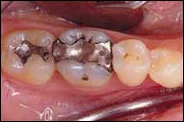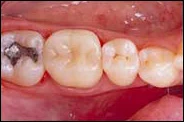Only Bonded Porcelain Veneers Are Durable
Please find Part 1 by clicking Teeth Bonding Procedures and learn more about the basics of bonding as used in cosmetic dentistry and explained in the 'Procedures' section.
If you want to learn what happens with the tooth during the preparation steps for dental bonding, go to Technical Specifications of Dental Bonding.
Reading all these references will give you a more complete picture about the bonding process for porcelain veneers to tooth structure. Understanding these principles will help you understand what a top cosmetic dentist does when he designs a smile that lasts for many years.
To bond a porcelain veneer to tooth structure, a variety of preparation techniques are being used in succession. This includes the surface treatment with acids, particle abrasion, various adhesives, and chemical couplers such as silane. Hydrofluoric acid is commonly used at various concentrations of when etching the inside (intaglio) surfaces of porcelain veneers.
Etching time has a great impact on the shear bond strength of porcelain restorations. Dental porcelain is composed of two phases, a glassy and a crystalline. HF selectively dissolves the glassy phase, which leaves a porous and retentive surface.
The contribution of silica dioxide, aluminum oxide, and potassium oxide, which vary in feldspathic porcelain, have an influence on the time necessary to create an acid-etch pattern on it surface. Many dental porcelains contain leucite crystals, which affect their various optical and physical properties.
Correct etching times and concentrations of HF are critical for an optimum retentive surface. On the other hand, the producer of Authentic recommends to a different protocol. The two lithium disilicate-based ceramics have entirely different specifications.
Prior to the treatment of the porcelain surface with the silane coupling agent, the etched inside surface of the porcelain has to be evaluated for white residues that are signs of over-etching the porcelain. These residues, which consist of porcelain salts and crystalline debris should be considered contaminants and be removed. This is best done with a rinse with ethanol and ultrasonic cleaning for several minutes to have a clean and chemically reactive porcelain surface for the next step – the application of silane.
The one silane that is used for the surface treatment of porcelain veneers and restorations is 3-methacryl-oxypropyl-trimethoxy-silane. It is a long molecule that has a methacrylate group at one end, which can co-polymerize with adhesives and dental resins. At the other end, it has the silicon group, which forms chemical bonds with the porcelain interface. It is therefore a valuable coupling agent in dentistry that links resin-based with inorganic materials, such as porcelains.
What happens when silane is used as a coupling agent?
Silane must be hydrolyzed to interact with the surfaces of porcelain veneers. This is achieved with acetic acid.
Here the silane molecules have covalently bonded to the porcelain and the adjacent silane molecules. Therefore, a polymer network ensues. At the top of the silane molecules are methacrylate groups that react with methacrylate groups of adhesive resins and composite materials.
A lot of research has been done to develop and improve dental zirconia materials and their bonding techniques. Due to the lack of etchibility, intaglio surfaces of dental zirconia restorations require a different kind of priming, such as phosphoric-acid methacrylate.
References for zironia research:
Tanis MC et al. Resin cementation of zirconia ceramics with different bonding agents. Biotechnol Biotechnol Equip. 2015 Mar 4; 29(2): 363–367).
Roperto R et al. Effect of different adhesive strategies on microtensile bond strength of computer aided design/computer aided manufacturing blocks bonded to dentin. Dental Res J (Isfahan). 2016; 13(2): 117–123.
Sari F. Shear bond strength of indirect composite material to monolithic zirconia. J Adv Prosthodont. 2016 Aug; 8(4): 267–274.
A great in-depth reference to the chemical aspects of porcelain bonding can be found in:
Alex G. Preparing Porcelain Surfaces for Optimal Bonding. J Functional Esthetics and Restorative Dentistry. Series 2, Number 1; 2006; 38-49.
Bonded Porcelain Crown





